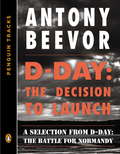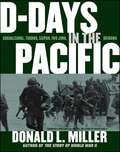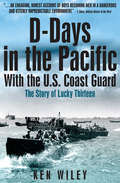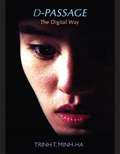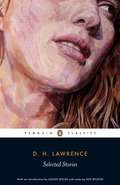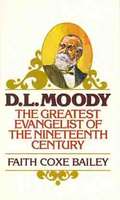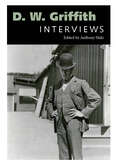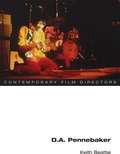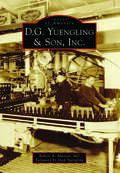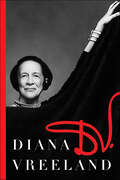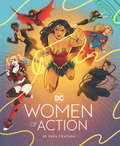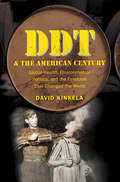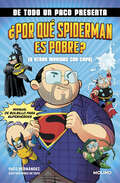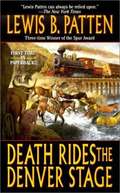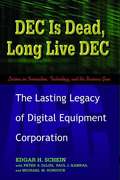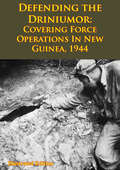- Table View
- List View
D-Day: The Soldiers' Story / 'Vivid, graphic and moving' Mail on Sunday
by Giles Milton'Vivid, graphic and moving' Mail on Sunday Book of the Year'It has a wonderful immediacy and vitality - living history in every sense' Anthony Horowitz'Fantastic' Dan Snow'Compellingly authentic, revelatory and beautifully written. A gripping tour deforce' Damien Lewis'Stirring and unsettling in equal measure, this is history writing at its most powerful' Evening StandardSeventy-five years have passed since D-Day, the day of the greatest seaborne invasion in history.The outcome of the Second World War hung in the balance on that chill June morning. If Allied forces succeeded in gaining a foothold in northern France, the road to victory would be open. But if the Allies could be driven back into the sea, the invasion would be stalled for years, perhaps forever.An epic battle that involved 156,000 men, 7,000 ships and 20,000 armoured vehicles, the desperate struggle that unfolded on 6 June 1944 was, above all, a story of individual heroics - of men who were driven to keep fighting until the German defences were smashed and the precarious beachheads secured. Their authentic human story - Allied, German, French - has never fully been told.Giles Milton's bold new history narrates the day's events through the tales of survivors from all sides: the teenage Allied conscript, the crack German defender, the French resistance fighter. From the military architects at Supreme Headquarters to the young schoolboy in the Wehrmacht's bunkers, D-Day: The Soldiers' Story lays bare the absolute terror of those trapped in the frontline of Operation Overlord. It also gives voice to those hitherto unheard - the French butcher's daughter, the Panzer Commander's wife, the chauffeur to the General Staff.This vast canvas of human bravado reveals 'the longest day' as never before - less as a masterpiece of strategic planning than a day on which thousands of scared young men found themselves staring death in the face. It is drawn in its entirety from the raw, unvarnished experiences of those who were there.
D-Day: The World War II Invasion That Changed History (Scholastic Focus)
by Deborah HopkinsonSibert Honor author Deborah Hopkinson brings her signature research and action-packed narrative style to one of the most crucial battles of WWII.Scholastic Focus is the premier home of thoroughly researched, beautifully written, and thoughtfully designed works of narrative nonfiction aimed at middle-grade and young adult readers. These books help readers learn about the world in which they live and develop their critical thinking skills so that they may become dynamic citizens who are able to analyze and understand our past, participate in essential discussions about our present, and work to grow and build our future.The WWII invasion known as D-Day was the largest military endeavor in history. By June 6, 1944, Hitler and his allies had a strong grip on the European continent, where Nazi Germany was engaged in the mass extermination of the Jewish people. The goal of D-Day was the total defeat of Hitler's regime, and the defense of free democracies everywhere. Knowing they had to breach the French coast, the US, Great Britain, and Canada planned for the impossible.D-Day was an invasion not for conquest, but liberation, and required years to plan and total secrecy to keep the advantage of surprise. Once deployed, Operation Overlord involved soldiers, sailors, paratroopers, and specialists. Acclaimed author Deborah Hopkinson weaves together the contributions of not only D-Day's famous players, but African Americans, women, journalists, and service members in a masterful tapestry of official documents, personal narratives, and archival photos to bring this decisive battle to vivid, thrilling life.
D-Day: The battle for Normandy
by Antony BeevorThe little-known drama of the last-minute decision to launch the invasion of Normandy--excerpted from the internationally bestselling D-Day: The Battle for Normandy In D-Day: The Decision to Launch, excerpted from Antony Beevor's bestselling book D-Day: The Battle for Normandy, readers get the little-known story of how the difficult decision was made to launch the Allied invasion of France on June 6, 1944. The stakes could not have been higher: if Operation Overlord were to fail, it would be a crushing blow to the Allies, a huge loss of both men and equipment. The decision of when to launch rested with supreme commander General Dwight D. Eisenhower, but it hinged on one factor: the weather. If there was too much cloud cover, the Allied bombers wouldn't be able to provide air support, and if the seas were too rough, the landing craft would be swamped. It fell to one man to predict the weather: Dr. James Stagg, the head of the meteorological team at Supreme Headquarters Allied Expeditionary Force. This riveting selection from D-Day, praised by Time as "a vibrant work of history that honors the sacrifice of tens of thousands of men and women," tells the fascinating inside story of one of the most important decisions of World War II.
D-Days in the Pacific
by Donald L. MillerAlthough most people associate the term D-Day with the Normandy invasion on June 6, 1944, it is military code for the beginning of any offensive operation. In the Pacific theater during World War II there were more than one hundred D-Days. The largest—and last—was the invasion of Okinawa on April 1, 1945, which brought together the biggest invasion fleet ever assembled, far larger than that engaged in the Normandy invasion.D-Days in the Pacific tells the epic story of the campaign waged by American forces to win back the Pacific islands from Japan. Based on eyewitness accounts by the combatants, it covers the entire Pacific struggle from the attack on Pearl Harbor to the dropping of atomic bombs on Hiroshima and Nagasaki. The Pacific war was largely a seaborne offensive fought over immense distances. Many of the amphibious assaults on Japanese-held islands were among the most savagely fought battles in American history: Guadalcanal, Tarawa, Saipan, New Guinea, Peleliu, Leyte Gulf, Iwo Jima, Okinawa. Generously illustrated with photographs and maps, D-Days in the Pacific is the finest one-volume account of this titanic struggle.
D-Days in the Pacific With the US Coastguard: The Story of Lucky Thirteen
by Ken WileyAn award-winning, personal account of US amphibious operations in WWII by a veteran Coast Guardsman—illustrated with photographs and drawings.During World War II, Ken Wiley was a Coast Guardsman on an attack transport in the Pacific. In this work of historical memoir, Wiley relates the complex and often nerve-wracking story of how the United States projected its power across six thousand miles of ocean. Each invasion was a swirl of moving parts, from frogmen to fire support, transport mother ships to attack transports. In this vivid account, Wiley “brings the reader close to the experiences of another band of brothers,” from the camaraderie of young men facing unimaginable circumstances to the last terrifying stage when courageous soldiers stormed the beaches (Military Illustrated).Wiley participated in the campaigns for the Marshall Islands, the Marianas, the Philippines, and Okinawa. He recounts each with a precise eye for detail, relating numerous aspects of landing craft operations, such as ferrying wounded, that are often overlooked.Winner of the 2008 Foundation for Coast Guard History Book Award.
D-Passage: The Digital Way
by Minh-ha T. TrinhD-Passage is a unique book by the world-renowned filmmaker, artist, and critical theorist Trinh T. Minh-ha. Taking as grounding forces her feature film Night Passage and installation L'Autre marche (The Other Walk), both co-created with Jean-Paul Bourdier, she discusses the impact of new technology on cinema culture and explores its effects on creative practice. Less a medium than a "way," the digital is here featured in its mobile, transformative passages. Trinh's reflections shed light on several of her major themes: temporality; transitions; transcultural encounters; ways of seeing and knowing; and the implications of the media used, the artistic practices engaged in, and the representations created. In D-Passage, form and structure, rhythm and movement, and language and imagery are inseparable. The book integrates essays, artistic statements, in-depth conversations, the script of Night Passage, movie stills, photos, and sketches.
D. B.
by Elwood ReidA stunning fictional imagining of legendary American folk hero D. B. Cooper's daring hijacking and its aftermath, by one of the toughest, most distinctive voices in American fiction. On the day before Thanksgiving 1971, just as a Seattle-bound 727 from Portland, Oregon, was taking off, a man calling himself D. B. Cooper handed a note to a flight attendant that said: "I have a bomb in my briefcase. " Touching down in Washington State, where airline officials and FBI agents met his demands--$200,000 and several parachutes--the passengers were released, and Cooper ordered the pilot to chart a course for Mexico City. But somewhere over the dense Pacific Northwest woods, Cooper jumped. No trace of him was ever found. This gutsy exploit made D. B. Cooper a legend and a folk hero, and it is the starting point for Elwood Reid's powerful examination of ways of living in America. Reid poses the question: Is it better to do one great thing in life or to grind out a righteous life? In Reid's version, D. B. Cooper is a Vietnam vet named Fitch, a man fed up with the timid course of his life and determined to do something about it. By pulling off the hijacking, he proves to himself that he is a man of destiny, capable of greatness. Or so it seems. He floats across the border to Mexico, drifting and lounging in the company of similar refugees and flotsam from the 1970s counterculture. In a parallel narrative, newly retired FBI Agent Frank Marshall has been cut adrift and now faces decades of purposelessness. Tempted to embark on an affair with a female witness he's been protecting, bored by leisure, and haunted by cases he couldn't solve, Frank agrees to help an eager young agent to look into the still-open D. B. Cooper case. When Fitch/Cooper, after years of cunning, exile, and silence, makes the mistake of falling for the wrong woman in Mexico, he is forced to return to America and the scene of his crime, and the two narratives intersect. The clean, taut prose that has become Reid's hallmark and his profound understanding of what work means and what the dream of escaping work really entails, make D. B. a unique and profound work of fiction.
D. G. Leahy and the Thinking Now Occurring (SUNY series in Theology and Continental Thought)
by Lissa McCullough; Elliot R. WolfsonThis book offers a critical introduction to the work of American philosopher D. G. Leahy (1937–2014). Leahy's fundamental thinking can be characterized as an absolute creativity in which all creating is "live"—a happening occurring now that manifests a supersaturated polyontological actuality that is essentially created by the logic that characterizes it. Leahy leaves behind the categorial presuppositions of modern thought, eclipsing both Cartesian and Hegelian subjectivities and introducing instead an essentially new form of thinking founded in a nondual logic of creation. The new thinking delineates the absolute unicity of existence as a creative interactivity beyond all traditional dichotomies (such as one vs. many, unity vs. plurality, identity vs. change): a fully "digitized" actuality that is nothing but newness, which inherently implies nothing but change. Through this new form of thinking, change itself is revealed to be the very essence of reality and mind. Any reader looking for a quantum leap beyond the thrall of modern and postmodern fixations is invited to hear and apprehend this new thinking that refuses to be conditioned by paradigms, categories, species, genera, walls, bridges, boundaries, or abstractions: an essentially free thinking that embodies creative novelty itself.
D. H. Lawrence - Selected Stories
by D. H. Lawrence Louise Welsh Sue WilsonD. H. Lawrence was one of the great short story writers of the 20th century. This new collection of ten stories shows the variety of his achievement as the works develop from an early realism towards myth and fairy tale, murder, and ghost stories. A scholarly tome for studying Lawrence's work, it includes a Foreword, (with footnotes), a time line of Lawrence's life, a List of Suggested Reading , extensive notes on the texts used and how they has been supported, the stories thenselves, then an extensive glossary and combined notes on the stories.
D. L. Moody: The Greatest Evangelist of the Nineteenth Century
by Faith Coxe BaileyD. L. Moody dared to take up a challenge and see what God could do with a life totally committed to Him. Here is the story of the greatest American evangelist of the 1800's and the founder of the Moody Bible Institute.
D. W. Griffith: Interviews (Conversations with Filmmakers Series)
by D. W. GriffithD. W. Griffith (1875–1948) is one of the most influential figures in the history of the motion picture. As director of The Birth of a Nation, he is also one of the most controversial. He raised the cinema to a new level of art, entertainment, and innovation, and at the same time he illustrated, for the first time, its potential to influence an audience and propagandize a cause. Collected together here are virtually all of the “interviews” given by D. W. Griffith from the first in 1914 to the last in 1948. Some of the interviews concentrate on specific films, including The Birth of a Nation, Intolerance, and, most substantially, Hearts of the World, while others provide the director with an opportunity to expound on topics of personal interest, including the importance of proper exhibition of his and other’s films, and his search for truth and beauty on screen. The interviews are taken from many sources, including leading newspapers, trade papers, and fan magazines. They are often marked by humor and by a desire to please the interviewer and thus the reader. Griffith may not have been particularly enthusiastic about giving interviews, but he seems always determined to put on a good show. Ultimately, D. W. Griffith: Interviews provides the reader with a unique insight into the mind and filmmaking techniques of a director whose work and philosophy is as relevant today as it was when he was at the height of his fame in the 1910s and 1920s.
D.A. Pennebaker (Contemporary Film Directors)
by Keith BeattieThis volume is the first book-length study of the extensive career and prolific works of D.A. Pennebaker, one of the pioneers of direct cinema, a documentary form that emphasizes observation and a straightforward portrayal of events. With a career spanning decades, Pennebaker's many projects have included avant-garde experiments (Daybreak Express), ground-breaking television documentaries (Primary), celebrity films (Dont Look Back), concert films (Monterey Pop), and innovative fusions of documentary and fiction (Maidstone). Exploring the concept of "performing the real," Keith Beattie interprets Pennebaker's films as performances in which the act of filming is in itself a performative transgression of the norms of purely observational documentary. He examines the ways in which Pennebaker's presentation of unscripted everyday performances is informed by connections between documentary filmmaking and other experimental movements such as the New American Cinema. Through his collaborations with such various artists as Richard Leacock, Shirley Clarke, Norman Mailer, and Jean-Luc Godard, Pennebaker has continually reworked and redefined the forms of documentary filmmaking. This book also includes a recent interview with the director and a full filmography.
D.G. Yuengling & Son, Inc.
by Robert A. Musson Dick YuenglingKnown as "America's Oldest Brewery," D. G. Yuengling & Son, Inc., of Pottsville has been in continuous operation since 1829. Since its start, Yuengling has been prudently managed by the Yuengling family. Overcoming the 14 dry years of Prohibition, Yuengling persevered due in part to the ingenuity and creativity of its owners and loyalty of its consumers. Unlike many of the regional brewers who were forced to close their doors over time, Yuengling found a niche for itself beginning in the late 1980s. With the introduction of Yuengling Lager and Black & Tan, the brand became a sensation in and around Philadelphia. Popularity of the beverages led to Yuengling being distributed in 14 states, making it the largest American-owned brewery. Through more than 220 historic images, D.G. Yuengling & Son, Inc., tells the story of this legendary American company.
D.H. Lawrence's Australia: Anxiety at the Edge of Empire
by David GameThe first full-length account of D.H. Lawrence’s rich engagement with a country he found both fascinating and frustrating, D.H. Lawrence’s Australia focuses on the philosophical, anthropological and literary influences that informed the utopian and regenerative visions that characterise so much of Lawrence’s work. David Game gives particular attention to the four novels and one novella published between 1920 and 1925, what Game calls Lawrence’s 'Australian period,' shedding new light on Lawrence’s attitudes towards Australia in general and, more specifically, towards Australian Aborigines, women and colonialism. He revisits key aspects of Lawrence’s development as a novelist and thinker, including the influence of Darwin and Lawrence’s rejection of eugenics, Christianity, psychoanalysis and science. While Game concentrates on the Australian novels such as Kangaroo and The Boy in the Bush, he also uncovers the Australian elements in a range of other works, including Lawrence’s last novel, Lady Chatterley’s Lover. Lawrence lived in Australia for just three months, but as Game shows, it played a significant role in his quest for a way of life that would enable regeneration of the individual in the face of what Lawrence saw as the moral collapse of modern industrial civilisation after the outbreak of World War I.
D.V.
by Diana Vreeland“An evening with D.V. is almost as marvelous as an evening with D.V. [herself]—same magic, same spontaneity and, above all, never a boring moment.”—Bill BlassD.V. is the mesmerizing autobiography of one of the 20th century’s greatest fashion icons, Diana Vreeland, the one-time fashion editor of Harper’s Bazaar and editor-in-chief of Vogue, whose incomparable style-sense, genius, and flair helped define the world of haute couture for fifty years. The incomparable D.V. proves herself a brilliant raconteur as she carries the reader along on her whirlwind life—from English palaces to the nightclubs of Paris in the 1930s to the heart of New York high society, hobnobbing with everyone who was anyone, from Queen Mary to Clark Gable to Coco Chanel.
DAEMONOMANIA: Book Three Of The Aegypt Cycle (Aegypt #3)
by John CrowleyWhen the world ends, it ends somewhat differently for each soul then alive to see it; the end doesn't come all at once but passes and repasses over the world like the shivers that pass over a horse's skin.<P> For the people in this novel, the concerns of everyday life -- children and love affairs, work and friendship -- are beginning to transmute into the extraordinary and to reveal the forces, dark and light, that truly govern their lives.<P> So it is for Pierce Moffett, would-be historian and author, who has moved from New York to the Faraway Hills, where he seems to discover -- or rediscover -- a path into magic, past and present. And so it is for Rosie Rasmussen, a single mother grappling with her mysterious uncle's legacy and her young daughter Samantha's inexplicable seizures. For Pierce's lover Rose Ryder, whose life is lived half in dream, another path unfolds: she's drawn into a cult that promises to exorcise her demons.<P> A great cycle of time is ending, as it did once before, in the bygone days of witchcraft and wars of religion. The lives of Renaissance wizard John Dee and rogue philosopher Giordano Bruno, who was burned at the stake, haunt the present: their stories, true and false, are being reenacted in the peaceful Faraway Hills and may hold the key to the future. <P> It is the dark of the year, between Halloween and the winter solstice, and the gateway is open between the worlds of the living and the dead. Pierce and Rosie, Samantha and Rose Ryder, and their enemies and allies -- who have powers hidden until now--must take sides in an age-old war that is approaching the final battle. <P> Or is it? In a John Crowley novel, nothing is as it seems. Crowley draws us into a cosmic tug-of-war between familiarity and strangeness, couples us with characters much like ourselves, and then works his own potent magic on the proceedings. Daemonomania is a journey into the very mystery of existence: what is, what went before, and what could break through at any moment in our lives.
DC By Metro: A History & Guide (History And Guide Ser.)
by Michelle GoldchainKnow where to get off withthe mass transit rider&’s guide to the Washington area&’s most notable historic sites—includes photos! Whether you&’re a local or a visitor, you can explore every museum, monument, mural, and more in this guide—each within walking distance of a Metro station. The Metro system covers more than 115 miles with ninety-one stations, allowing millions each year to easily access some of the area&’s most beautiful, celebrated locations. Don&’t miss President Lincoln&’s Cottage in Petworth or the Friendship Archway in DC&’s Chinatown. Learn the history of Wolf Trap and the story behind the Big Chair in Anacostia. Author Michelle Goldchain is your guide to the capital&’s famous sites and best hidden attractions—and to the system that provides the simplest and most affordable way to reach them.
DC Go-Go: Ten Years Backstage (American Heritage)
by Chip PyDC Represent!There's a party over here, there's a party over there! In go-go the party never stops, and neither does the beat. The bands, the stars, the clubs, the spots, the sweat, the late nights and the passion are the sound of the city--all photographically captured and preserved right here. For those who know go-go this book is a documentary celebration. Shout yourself out with a special photographic section dedicated to the fans. For those who don't know, this book is a peek into that world through the lens of photographer Chip Py. Once Chuck Brown's official photographer, his go-go collection is now part of the People's Archive at the DC Public Library. Discover the district's distinctive music, its artists, its culture, and why it has become The Official Music of Washington, D.C.
DC Ultimate Character Guide New Edition
by DKIs Superman the strongest Super Hero alive? Where is Wonder Woman from? Is Darkseid the baddest Super-Villain ever? Who is the fastest man alive? Who are Batman’s greatest foes? The answers to this and much more can be found in the DC Ultimate Character Guide: New Edition. Written by a DC expert, this beautifully illustrated encyclopedia features more than 230 incredible DC characters, including Batman, Harley Quinn, Justice League, Aquaman, and so many more. The epic, DC Universe-changing Rebirth event was followed by the momentous Dawn of DC, which affected many characters and their stories. This comprehensive guide explores these changes alongside stunning new comic images, vital statistics, and key details of each character’s powers, from super-strength to sorcery. The DC Ultimate Character Guide: New Edition is guaranteed to enthral young comics fans for hours on end. All DC characters and elements © & ™ DC. (s24)
DC: Women of Action
by Shea FontanaFor decades, DC Super Heroes have inspired us to reach new heights, find strength in adversity, and access our inner power. This gorgeously illustrated collection tracks this progress, profiling the fiercest, strongest, and most independent female Super Heroes and Super-Villains in the DC Universe, along with the real-life women integral to their development. Featuring Wonder Woman™, Lois Lane, Batgirl, Bumblebee, Hawkgirl, Black Canary, Amanda Waller, and many more, this lush volume is a vivid celebration of the amazing, inspirational women of DC.All DC characters and elements © & ™ DC Comics. (s19)
DDT and The American Century
by David KinkelaPraised for its ability to kill insects effectively and cheaply and reviled as an ecological hazard, DDT continues to engender passion across the political spectrum as one of the world's most controversial chemical pesticides. InDDT and the American Century, David Kinkela chronicles the use of DDT around the world from 1941 to the present with a particular focus on the United States, which has played a critical role in encouraging the global use of the pesticide. The banning of DDT in the United States in 1972 is generally regarded as a signal triumph for the American environmental movement. Yet DDT's function as a tool of U. S. foreign policy and its use in international development projects designed to solve problems of disease and famine made it an integral component of the so-called American Century. The varying ways in which scientists, philanthropic foundations, corporations, national governments, and transnational institutions assessed and adjudicated the balance of risks and benefits of DDT within and beyond America's borders, Kinkela argues, demonstrates the gap that existed between global and U. S. perspectives on DDT. DDT and the American Centuryoffers a unique approach to understanding modern environmentalism in a global context.
DE TODO UN PACO PRESENTA (Y otras movidas con capa): Manual de bolsillo para superhéroes
by Paco HernándezDescubre todos los secretos de los superhéroes y ¡conviértete en uno de ellos! ¿Qué hay que hacer para convertirse en superhéroe? Para empezar, saberlo todo de ellos. ¿Acabas de llegar de otro planeta y el sol te da poderes? Pues ten cuidado con las alergias, que hay más tipos de kryptonita que miembros de La Liga de la Justicia.¿Eres multimillonario y estás aburrido? Te recomendamos los mejores artilugios en los que gastar tu fortuna y con los que seguir evitando ir a terapia. ¿Te ha picado una araña radiactiva? Múdate a Nueva York porque en tu pueblo no hay rascacielos de los que columpiarse. ¿Que vivir en Nueva York es muy caro? Bueno, ahora ya sabes por qué Peter Parker es pobre.
DEATH RIDES THE DENVER STAGE
by Lewis B. PattenClee Fahr has just arrived by stage in Denver City, Colorado. It is 1861 and the War Between the States has broken out back in the East. Torn apart by opposing military and political sympathies, the town is a tinderbox of treachery and suspicion. Eames Jeffords, an old enemy of Clee's from the South, is buying arms for the Confederate cause. Sam Massey, a mine owner, is raising a company of volunteers to march east and join the Union forces. Although he was born in the North, Clee has divided sympathies. But he's caught in the middle, and both sides see him as a threat--a threat that needs to be removed.
DEC Is Dead, Long Live DEC: The Lasting Legacy of Digital Equipment Corporation
by Edgar Schein Paul KampasDEC Is Dead, Long Live DEC tells the 40-year story of the creation, demise, and enduring legacy of one of the pioneering companies of the computer age. Digital Equipment Corporation created the minicomputer, networking, the concept of distributed computing, speech recognition, and other major innovations. It was the number two computer maker behind IBM. Yet it ultimately failed as a business and was sold to Compaq Corporation. What happened?Edgar Schein consulted to DEC throughout its history and so had unparalleled access to all the major players, and an inside view of all the major events. He shows how the unique organizational culture established by DEC's founder, Ken Olsen, gave the company important competitive advantages in its early years, but later became a hindrance and ultimately led to the company's downfall. Schein, Kampas, DeLisi, and Sonduck explain in detail how a particular culture can become so embedded that an organization is unable to adapt to changing circumstances even though it sees the need very clearly.The essential elements of DEC's culture are still visible in many other organizations today, and most former employees are so positive about their days at DEC that they attempt to reproduce its culture in their current work situations. In the era of post-dot.com meltdown, raging debate about companies "built to last" vs. "built to sell," and more entrepreneurial startups than ever, the rise and fall of DEC is the ultimate case study.
DEFENDING THE DRINIUMOR: Covering Force Operations in New Guinea, 1944 [Illustrated Edition]
by Dr Edward J. DreaIllustrated with 32 maps, 8 Illustrations and 4 charts.On the night of 10-11 July 1944, several thousand Japanese infantrymen attacked and broke through U.S. Army covering force units defending the Driniumor River about twenty miles east of Aitape, New Guinea. For the next month U.S. Army troops were locked in a battle of attrition with the Japanese, as the Americans fought to restore the breakthrough line and destroy the Japanese attackers. This Leavenworth Paper describes the events leading up to the Japanese breakthrough and the subsequent American counterattacks to restore the original defensive positions.This Leavenworth Paper provides a day-by-day account of the course of the battle. Naturally not every moment was spent fighting, so commensurate attention is given to tactical planning, logistics, combat support-those oft-times overlooked functions that are only noticeable by their absence. There is sufficient detail for an in-depth analysis of both combatants' doctrine, effectiveness of training, tactics, leadership, and unit cohesion...The combatants created their doctrine and applied it in combat isolated from the "Big Picture." Their concern was more basic, to survive. Training, previous combat experience, and leadership seem to have been the ingredients that most contributed to unit cohesion in the struggle. Those naturally developed unit bonds provided the underpinning for morale factors essential in protracted battle in a harsh natural environment. By the same token, one should not infer that tactics were therefore flawless and leadership bold and imaginative. In most cases, the opposite appears true. The reasons for this apparent contradiction unfold with the developing battle. By approaching these questions from the small unit perspective, one gains a fresh insight into the U.S. Army's historic jungle warfare campaigns as well as a tactical appreciation of the enormous difficulties both sides experienced in the jungled terrain.


